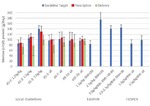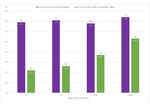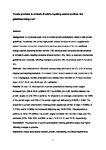Protein provision in critically ill adults requiring enteral nutrition: Are guidelines being met?
| dc.contributor.author | Collinson, Avril | |
| dc.contributor.author | Mitchell, A | |
| dc.contributor.author | Taylor, S | |
| dc.contributor.author | Downer, C | |
| dc.contributor.author | Clemente, R | |
| dc.contributor.author | Allan, K | |
| dc.contributor.author | Greer, F | |
| dc.date.accessioned | 2018-10-31T13:43:56Z | |
| dc.date.issued | 2019-02 | |
| dc.identifier.issn | 1941-2452 | |
| dc.identifier.issn | 1941-2452 | |
| dc.identifier.uri | http://hdl.handle.net/10026.1/12697 | |
| dc.description.abstract |
<jats:title>Abstract</jats:title><jats:sec><jats:title>Background</jats:title><jats:p>In a previous audit, 81% of enteral protein prescriptions failed to meet protein guidelines. To address this, a very high‐protein enteral formula and protein supplements were introduced, and protein prescriptions were adjusted to account for nonnutrition energy sources displacing enteral formula. This follow‐up audit compared protein provision in critically ill adults requiring exclusive enteral nutrition (EN), first, with local and international guidelines, and second, after changes to practice, with the previous audit in the same intensive care unit (ICU).</jats:p></jats:sec><jats:sec><jats:title>Methods</jats:title><jats:p>Data were collected from 106 adults consecutively admitted to the ICU of a U.K. tertiary hospital and requiring exclusive EN ≥3 days. Protein targets based on local guidelines (1.25, 1.5, or 2.0 g/kg/d), nutrition prescription, and delivery were recorded for 24 hours between days 1–3, 5–7, 8–10, and 18–20 post‐ICU admission.</jats:p></jats:sec><jats:sec><jats:title>Results</jats:title><jats:p>The proportion of day 1–3 protein prescriptions meeting protein targets increased from 19% in 2015 to 69% in 2017 (<jats:italic>P</jats:italic> < .0005, φ = 0.50). The median percentage of protein target delivered was lower than prescribed (79% vs 103%; (<jats:italic>P</jats:italic> < .0005; <jats:italic>r</jats:italic> = 0.53) and EN delivery only met the target of 22% of patients. The proportion of protein prescriptions meeting protein targets was similar for days 1–3 (69%), 5–7 (71%), and 8–10 (68%), but increased slightly by days 18–20 (74%). The proportion of patients for which EN delivery met protein targets increased with the number of days post‐ICU admission (22%, 26%, 37%, and 53% for days 1–3, 5–7, 8–10, and 18–20, respectively).</jats:p></jats:sec><jats:sec><jats:title>Conclusion</jats:title><jats:p>The proportion of protein prescriptions meeting guideline targets was higher after changes to practice.</jats:p></jats:sec> | |
| dc.format.extent | 123-130 | |
| dc.format.medium | Print-Electronic | |
| dc.language | en | |
| dc.language.iso | en | |
| dc.publisher | SAGE Publications | |
| dc.subject | critical care | |
| dc.subject | critical illness | |
| dc.subject | dietary proteins | |
| dc.subject | enteral nutrition | |
| dc.subject | intensive care unit | |
| dc.subject | nutrition assessment | |
| dc.subject | nutrition support | |
| dc.subject | quality improvement | |
| dc.title | Protein provision in critically ill adults requiring enteral nutrition: Are guidelines being met? | |
| dc.type | journal-article | |
| dc.type | Journal Article | |
| plymouth.author-url | https://www.webofscience.com/api/gateway?GWVersion=2&SrcApp=PARTNER_APP&SrcAuth=LinksAMR&KeyUT=WOS:000459619900012&DestLinkType=FullRecord&DestApp=ALL_WOS&UsrCustomerID=11bb513d99f797142bcfeffcc58ea008 | |
| plymouth.issue | 1 | |
| plymouth.volume | 34 | |
| plymouth.publication-status | Published | |
| plymouth.journal | Nutrition in Clinical Practice | |
| dc.identifier.doi | 10.1002/ncp.10209 | |
| plymouth.organisational-group | /Plymouth | |
| plymouth.organisational-group | /Plymouth/Faculty of Health | |
| plymouth.organisational-group | /Plymouth/Faculty of Health/School of Health Professions | |
| plymouth.organisational-group | /Plymouth/REF 2021 Researchers by UoA | |
| plymouth.organisational-group | /Plymouth/REF 2021 Researchers by UoA/UoA03 Allied Health Professions, Dentistry, Nursing and Pharmacy | |
| plymouth.organisational-group | /Plymouth/Research Groups | |
| plymouth.organisational-group | /Plymouth/Research Groups/Institute of Health and Community | |
| plymouth.organisational-group | /Plymouth/Research Groups/Plymouth Institute of Health and Care Research (PIHR) | |
| plymouth.organisational-group | /Plymouth/Users by role | |
| plymouth.organisational-group | /Plymouth/Users by role/Academics | |
| dc.publisher.place | United States | |
| dcterms.dateAccepted | 2018-09-29 | |
| dc.rights.embargodate | 2019-2-12 | |
| dc.identifier.eissn | 1941-2452 | |
| dc.rights.embargoperiod | Not known | |
| rioxxterms.versionofrecord | 10.1002/ncp.10209 | |
| rioxxterms.licenseref.uri | http://www.rioxx.net/licenses/all-rights-reserved | |
| rioxxterms.licenseref.startdate | 2019-02 | |
| rioxxterms.type | Journal Article/Review |




